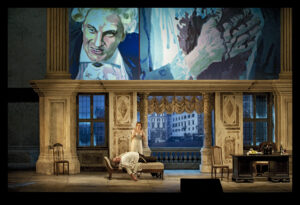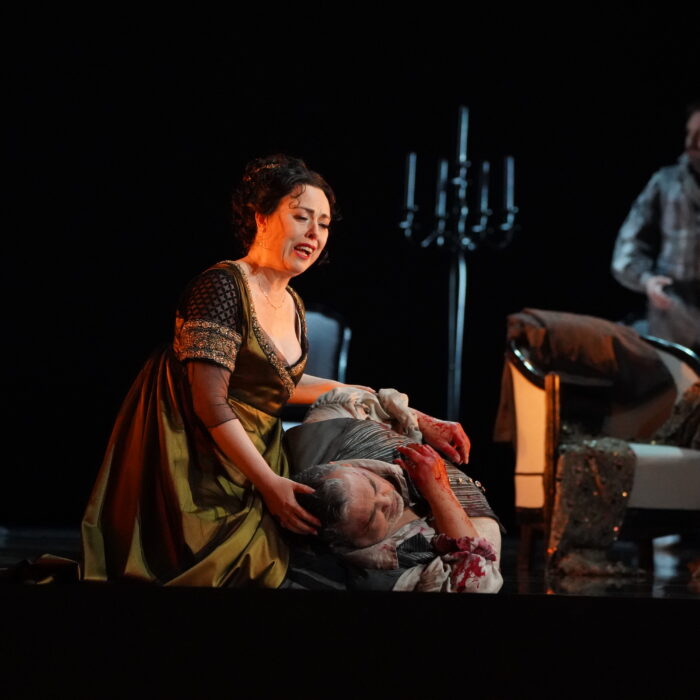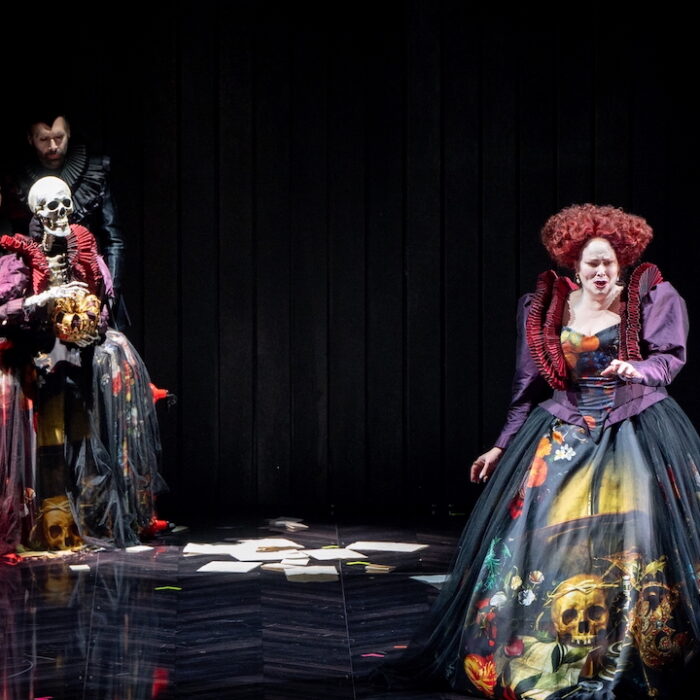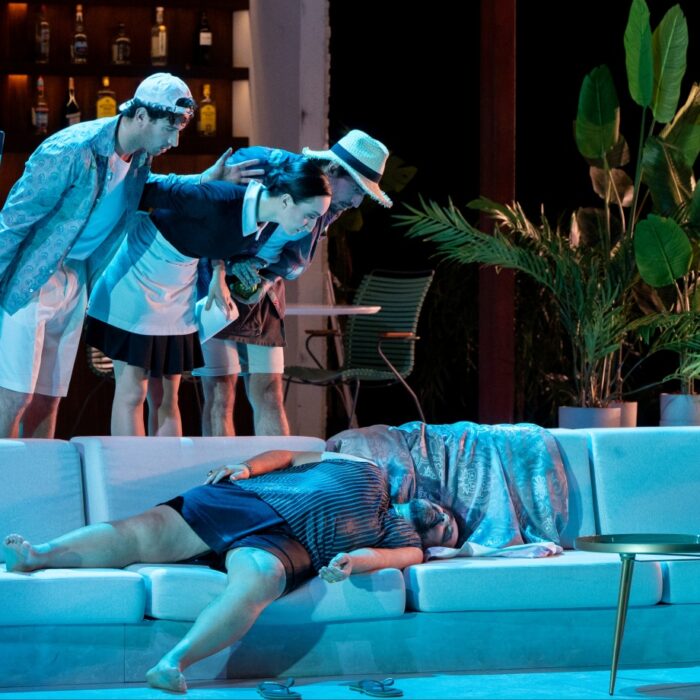
Staatsoper Unter den Linden 2024-25 Review: Tosca
Puzzling Production Overlooks Puccini’s Intent
By Laura Servidei(Credits: Hermann und Clärchen Baus)
Giacomo Puccini’s “Tosca,” adapted from a play by Victorien Sardou, was famously criticized by American musicologist Joseph Kerman, who dismissed it as a “shabby little shocker” and predicted its swift decline from the operatic canon. Despite this, “Tosca” endures as a favorite among audiences, thanks to Puccini’s brilliant music and masterful orchestration that elevate it to the status of a masterpiece. One of the most notable aspects of “Tosca” is its “cinematographic” quality. The drama unfolds over the course of less than 24 hours, the plot is more plausible than in most operas. The timing of the story is nearly in real-time, and the dialogues are intense, direct, and vividly descriptive of the action.
The Revival of a Puzzling Production
None of this was present in Alvis Hermanis’s 2014 production, where the director chose to have the characters barely interact, draining the drama from the outset. In the first act, Floria Tosca, a famous opera singer, visits her lover, the painter Mario Cavaradossi, in the church where he is busy painting religious scenes. She is jealous, and he reassures her in a long love scene filled with duets, arias, and playful moments – “Oh my, you’ve messed up my hair.” However, very little of this emotional exchange was captured in a scene where Tosca and Cavaradossi hardly even looked at each other. The few embraces they did share were brief and awkward, failing to reflect the passion conveyed by the music. While it could have been easy to blame the singers’ lack of acting skills, what unfolded in the second act made it clear that this was a deliberate yet puzzling choice by the director.
The second act of “Tosca” is one of the most iconic in the entire operatic repertoire, in no small measure because it is the only video recording left by the legendary Maria Callas. This is where the plot takes a dark and gruesome turn: Cavaradossi is being tortured offstage, his screams filling the air, while Tosca is onstage, torn with anguish and on the verge of revealing the secret the police are trying to extract from him. Meanwhile, Scarpia, the chief of police, is blackmailing her, demanding she submit to his sexual advances in exchange for her lover’s life. In this production, however, the entire scene unfolded with the main characters positioned in distant corners of the room. When Cavaradossi, bloodied and unconscious, was dragged into the room, Tosca did not rush to comfort him. And during Scarpia’s assault, as he shouted, “Mine! You’re mine!” and she cried, “No! Don’t touch me! I’d rather kill myself!” they sat calmly in chairs on opposite sides of the stage. Unbelievable.
Naturally, the finale was altered as well. Instead of Tosca leaping from the heights of Castel Sant’Angelo after her lover is executed, she simply walked toward the audience with her arms outstretched. It leaves one questioning why they even bothered with a staged production— a concert performance would have been both more honest and far more enjoyable.
A Great Trio of Principals
Amidst all this, the trio of principal singers was a true delight. Lise Davidsen was a magnificent Tosca, her upper register powerful and thrilling. Her entire second act was spectacular, with high C6 that were secure and forceful, complemented by a well-controlled, intense vibrato. She conveyed Tosca’s desperation with overwhelming intensity, yet always within the bounds of elegance and refined musicality. Her “do della lama” in Act three was truly earth-shattering. While the dramatic affect of her voice was her greatest strength, she was equally impressive in the more lyrical moments, delivering a seductive tone in the Act one duet and a deeply moving “Vissi d’arte,” where her emotional build to the high A was heartbreaking. Her only (minor) flaw was her less-than-perfect Italian pronunciation, as she did not seem entirely comfortable with the language.
Freddie de Tommaso, in the role of Tosca’s lover, was a natural fit, with his powerful tenor perfectly suited to the part. His voice had a spontaneous quality that conveyed youth and passion, and his high notes were naturally strong and well-placed, holding their own alongside Davidsen’s—no small achievement. Occasionally, he employed a charming glottal attack, reminiscent of an old-fashioned “sob,” which added a touch of endearing vulnerability to his performance. His rendition of “Vittoria!” on a high A-sharp, divided into four syllables to emphasize each vowel, was another old-school quirk that worked beautifully—his high note was magnificent. While his mezza voce was not at its best, he used it sparingly, opting instead for a well-supported and effective piano in moments like “E lucevan le stelle.”
Gerald Finley’s baritone was perhaps too smooth and beautiful for the role of Scarpia, yet he still managed to deliver a convincing portrayal of the villain. He used his voice aggressively, cleverly applying accents to make his otherwise remarkable legato less polished, injecting venom into his phrasing. His “Sì, mi dicon venal” was sung with both passion and disdain, featuring an excellent legato and secure, confident high notes. Finley appeared less hindered by the direction than his co-stars, navigating it effectively for the most part.
A Legend to Lead Them All
A living legend, Zubin Mehta, conducted the performance at 88 years old, leading the Staatskapelle in a masterful interpretation of the score. He favored broad tempi, and at times the singers seemed to long for a quicker, more fluid pace—for example during the first act duet “Qual occhio al mondo.”
Nevertheless, the singers displayed impressive breath control, skillfully adapting to the Maestro’s slower tempo. Mehta’s interpretation was intimate and affectionate, almost a love letter to Puccini and his magnificent orchestration, carefully highlighting the finer details without resorting to any cheap effects. The introduction and accompaniment to “E lucevan le stelle” felt ethereal, almost otherworldly. The brass, in particular, maintained a noble tone throughout, never sounding too loud or harsh.



